Catalogue > Liste par artiste
Parcourez la liste complète des artistes présentés dans le cadre des Rencontres Internationales depuis 2004. Utilisez le filtre alphabétique pour affiner vos recherches.
Miska Michael Knapek
Catalogue : 2010kiasma cafe north | Animation | | couleur | 3:5 | Danemark, Finlande | 2008
Miska Michael Knapek
kiasma cafe north
Animation | | couleur | 3:5 | Danemark, Finlande | 2008
Through a spatiotemporal representation twenty-two hours of a central Helsinki cafe`s life, asking to our permanence and soul of being. How are we, beyond the instants? Every animation frame holds twenty-two hours dispersed through its surface, linearly as if the motif`s time was scanned horizontally. Every subsequent animation frame moves the time`s position across the motif, revealing each bit at a slightly later time. Tracing the life in a watering hole of society, a cafe, the work juxtaposes the static built environment and the fluidity of being. The cafe-goers stay long enough for them to be visually caught, depicted, the essence of their being, almost as if it were their souls, are like colours spilled running in the rain. A blur in motion. Cyclically appearing and disappearing daily.
Miska Knapek is an artist designer, with a past in Graphic Information Design (BA) and graduate studies in artistic interaction design, currently based at Media Lab Helsinki. He explores chaotic patterns and challenging fundamental perceptions of society, optics, time, and space. Applying information visualisation techniques, to photographic/sensory/datamined material, Knapek?s work traces the hidden lives of nature, society and people?s immediate personal surrounds. His work has been exhibited internationally, including at Ars Electronica and Transmediale.
Catalogue : 2009longlapses: mannerheimintie south | Animation | | couleur | 3:58 | Danemark, Finlande | 2007
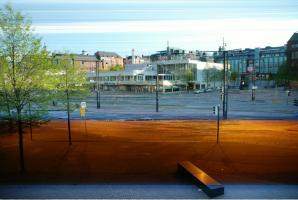
Miska Michael Knapek
longlapses: mannerheimintie south
Animation | | couleur | 3:58 | Danemark, Finlande | 2007
14:00-04:00 dans une rue animée d?Helsinki, en mai. Le projet « Longlapses » scrute la perception humaine, les brefs moments d?attention de la mémoire et les longs oublis. « Longlapses » de Miska Knapek vise à ouvrir les yeux et les esprits à la vie, dans des moments d?attention plus longs, pour retrouver la trace de l?être chaotique caché de la société et de la nature. Dans des traces et un temps comprimés, les mouvements de la nature sont pris entre la lumière changeante et l?ombre, mais il en va de même pour l?« être » de la société, qui trace sa vie visuellement. Comme si un objet physique ? le sommeil-réveil-départ-travail-transport-retour-sommeil de la société ? s?imprimait lui-même visuellement.
Né en 1975, Miska Knapek est un artiste designer. Après une licence en design d?information graphique, et des études supérieures en design d?interaction artistique, il est basé maintenant au Media Lab d?Helsinki (Finlande). Il explore les modes chaotiques et les stimulantes perceptions fondamentales de la société, l?optique, le temps et l'espace. En appliquant des techniques de visualisation d?informations à du matériel photographique, sensoriel, ou de data mining, l??uvre de Knapek retrace les vies cachées de la nature, de la société et de l?environnement immédiat et personnel des gens. Son travail a été exposé internationalement, notamment à Ars Electronica et à Transmediale.
John Kneller
Catalogue : 2007This film has no commercial value | Film expérimental | 16mm | couleur | 23:30 | Canada | 2006
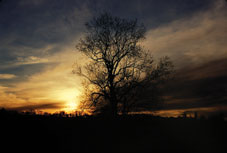
John Kneller
This film has no commercial value
Film expérimental | 16mm | couleur | 23:30 | Canada | 2006
Ce film a été fait de façon traditionnelle sur une pellicule utilisant un procédé basé sur la méthode de production. Ce sont les efforts respectifs d'un artiste de l'image et d'un artiste du son. Ce film se concentre sur l'environnement naturel construit par l'homme, capturant à l'aide de la camera et d' appareils spécialisés, un phénomène qui est invisible à l'oeil nu. Cette compression du temps passé est augmenté par l'usage automatisé du panoramique, de l'inclinaison et du zoom mécanique conçus par le cinéaste. L'image qui en résulte est une hyper-réalité des paysages en général et de paysages urbains, comme capturés et transformés à travers les moyens d'une médiation mécanique. La création sonore est presque totalement effacée par les sons naturels enregistrés et les performances musicales de différents environnements, la tension Romantique de la musique est tendue par les représentations lyriques de la nature et de l'environnement. La médiation délibérée des appareils de son et d'image suggère que notre relation avec l'environnement ne peut plus jamais être vu en dehors du domaine politique, la musique sert de requiem pour la spoliation de la terre par l'Homme. Les images d'un phénomène tel que l' "Aurore Boréalis" sont soumis à un long procédé cinématographique qui les transforment, transformant le phénomène qui est exclusivement crée par le procédé du film lui-même, particulièrement par des moyens d'imprimante optique et des mats progressifs faits-mains sur film et performant par la suite des opérations répétées en combinant et recombinant à l'aide des mats, au point d'arriver à une abstraction complète de l'image. Ce film est "coupable" dans ce qu' il veut exposer, le trouble avec cette tendance post-moderne envers le spectacle, le film dépouille la nature et l'environnement les présentant non en tant que telles mais avec l'intervention et la manipulation de l'homme.
John Kneller - Biographie John Keller a obtenu son diplôme à l' Unversité de Toronto, il a suivi un programme d'études du Cinéma en 1988 et a depuis fait des films inhabituels. Sa réserve d'échanges est le procédé créatif et consommateur de temps d'une impression optique et d'une manipulation accélérée. Il enseigne actuellement le cinéma au "Sheridan College" et poursuit une Maitrise en Cinéma (MFA) à l'Université York de Toronto. Des travaux d' impressions d'optiques récentes et en cours de réalisation ont été conçus pour les cinéastes canadiens Steve Sanguedolce, Phil Hoffman et Sol Nagler.Le "Festival du Film Winnipeg Experimental and Underground" (WNDX) si fréquenté , présentant la cours de maître des impressions d'optique, a présenté de nouveaux travaux en cours, "Homecoming Montreal 1950" , un film qui se sert de "Kodachrome" original et fait optiquement 3 séparations de couleur rouge, verte, et bleue et reprend ensuite fidélement, la couleur initiale mais qui plus tard se sert d' interventions et d'expériences accrues. C'est une oeuvre de compagnons 6 minutes plus courte que le long film de cette même année intitulé " This Film has No Commercial Value" 23 mins. 2006 qui est une vision méditée du dur mais beau paysage canadien.
Thomas Kneubühler
Catalogue : 2015Forward Looking Statements | Doc. expérimental | hdv | couleur | 3:47 | Canada | 2014
Thomas KneubÜhler
Forward Looking Statements
Doc. expérimental | hdv | couleur | 3:47 | Canada | 2014
A conference call by investors of a planned iron mine provides the soundtrack for a ride over the land which the company wants to exploit. The land in question is a traditional hunting ground for the Inuit community of Aupaluk, located in Canada's far North. The village has already been relocated in the 1980 and is now again under threat. The term "forward looking statements" is used in the world of investors to describe future events which are subject to certain risks and uncertainties.
Born in Solothurn, Switzerland, Thomas Kneubühler has been living in Canada since 2000. In 2003, he completed a Master’s degree in Studio Arts at Concordia University, Montreal. His work often deals with social issues and how technology is affecting people’s lives. His work has been presented in many exhibitions in both Europe and North America, most recently at the Québec Triennial at the Musée d’art contemporain de Montréal (2011), at the Centre culturel canadien, Paris (2012) and at the Centre Pasquart, Bienne (2014). In 2011 he was awarded the Pratt & Whitney Canada Prize of the Conseil des arts de Montréal, and in 2012 the Swiss Art Award by the Ministry of Culture Switzerland. «Whether it is the ambiguous boundaries of public and private space, the all-pervasive spectre of security surveillance or even the radiant, if dehumanizing, beauty of cityscapes, Kneubühler’s practice tellingly identifies the co-existing insecurities, uncertainties and subtle pleasures embedded in the structures of modern life.» (Bryne McLaughlin, Canadian Art)
Catalogue : 2014Days in Nights | Doc. expérimental | | couleur | 3:45 | Canada | 2013
Thomas KneubÜhler
Days in Nights
Doc. expérimental | | couleur | 3:45 | Canada | 2013
It is hard to navigate in the dark, especially in an unknown territory. Over time, the eyes adjust to the darkness, and the new environment starts to emerge. This video was made during an artist residency at CFS Alert, a military and research station in the high Arctic. CFS Alert is the northernmost settlement in the world, 800 km from the North Pole. From October to early March there is polar night, with no direct sunlight. Most people at the station are there for limited time, on average 3 to 6 months.
Thomas Kneubühler vit au Canada depuis 2000. Il est titulaire d?une maîtrise en beaux arts de l?Université Concordia. Son travail a été présenté dans de nombreuses expositions individuelles au Canada et dans le cadre d?expositions collectives au Canada, en Chine, en Suisse, aux Pays-Bas, en Allemagne et au Mexique.
Francois Knoetze, Russel Hlongwane, Amy Louise Wilson
Catalogue : 2023Dzata: The Institute of Technological Consciousness | Vidéo expérimentale | mp4 | couleur | 8:23 | Afrique du sud | 2023
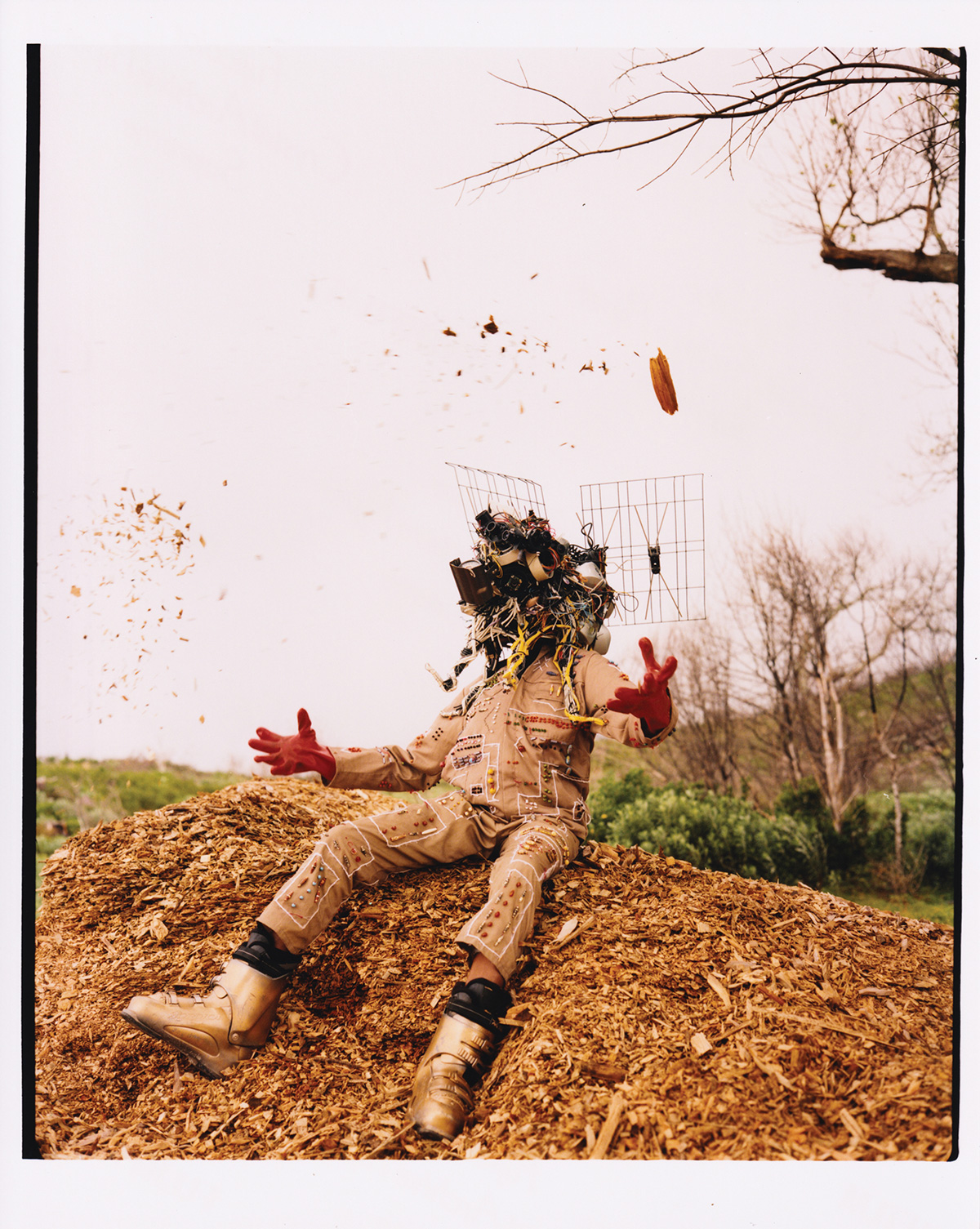
Francois Knoetze, Russel Hlongwane, Amy Louise Wilson
Dzata: The Institute of Technological Consciousness
Vidéo expérimentale | mp4 | couleur | 8:23 | Afrique du sud | 2023
Dzata: The Institute of Technological Consciousness is a creative research project by South African artists Russel Hlongwane, Francois Knoetze and Amy Louise Wilson. In fabricating a fictional institute and its archive, the artists explore and imagine vernacular technological practices operating across the African continent. An intertextual conversation between the documentary and the poetic, the video operates as an in-house media assemblage created for the preservation of the institute’s activities and ideas. The project aims to foreground indigenous technological knowledge and to explore how science, technology and innovation are part of a long interlinked process of accumulative knowledge production which extends long into the past. The work builds on the field of technopolitical research to formulate a multi-scalar history and future of technological creativity. Positioning the triumphs and failures of the everyday in the future-oriented technoscientific, the work unfolds the idea of development as a historical process Africans shaped.
Russel Hlongwane works in the production and assembly of culture. His area of interest is in heritage, tradition and modernity in South Africa. He moves between art-making (installation and film) and curating. His performance work operates as a bridge to transmit his academic interest to a broader audience, while his writing practice moves between academia, policy and art journals. His most recent peer reviewed paper is titled ‘Transcendental Technologies, Mother Tongues and Space (2022). He works intentionally with language (isiZulu) as a way to mobilise ideas contained in supressed histories. His work, Ifu Elimnyama (The Dark Cloud) has featured in six exhibitions and won the Sharjah Film Platform Jury Award. He curated the Bristol based Cntrl Shift Network festival that featured filmic works from the global south confronting the relationship between technology and the continent. Lo-Def Film Factory (Francois Knoetze & Amy Louise Wilson) is a DIY art duo who work across archival research, dramaturgy and visual strategies with video art, collage, sculptural installation and virtual reality. The duo aims to create a space for storytelling through the democratization of filmmaking via video by and for underrepresented communities across Southern Africa. They run workshops and work with various communities, placing value on the transmission ideas and lived experience over high production values. Their VR experience and research project The Subterranean Imprint Archive explores the legacy of technologies used in the extraction of mineral resources in Central and Southern Africa. It has been shown at the International Film Festival Rotterdam, University of African Futures (France), MUTEK Montreal and the Geneva International Film Festival. Amy and Francois have exhibited at the ZKM Center for Art and Media, The Centre Pompidou, The Dakar Biennale and the Akademie Der Kunste, Berlin.
Francois Knoetze, Amy Louise Wilson
Catalogue : 2026Concept Drift | Installation multimédia | 0 | couleur | 20:0 | Afrique du sud, 0 | 2025

Francois Knoetze, Amy Louise Wilson
Concept Drift
Installation multimédia | 0 | couleur | 20:0 | Afrique du sud, 0 | 2025
Concept Drift est un jeu interactif et une œuvre vidéo qui rendent visibles l’enchevêtrement entre production du savoir, exploitation coloniale et puissance technologique en Afrique du Sud. Le titre renvoie au terme de drift en apprentissage automatique, qui désigne la manière dont la performance d’un modèle entraîné sur des données historiques devient obsolète lorsqu’il est confronté au réel. Dans le schéma computationnel classique, les données entrent et la règle modélisée algorithmiquement calcule la sortie — mais comprimer ou modéliser un système complexe sans en réduire la complexité demeure impossible. L’œuvre mobilise des modèles et images 3D générés par IA, des collages faits main, du stop-motion, des environnements construits dans un moteur de jeu, des images d’archives, des costumes sculpturaux et des performances pour constituer un archivage des infrastructures et réseaux matériels des algorithmes tels qu’ils s’appliquent aux territoires et aux vies sud-africaines : visualisant un anti-modèle des liens entre l’Afrique du Sud et l’ordre computationnel mondial. En traversant temps et territoires — des compounds miniers sous haute surveillance aux chaînes de production industrielles et aux banlieues résidentielles — le monde du jeu dévoile comment la logique et les pratiques algorithmiques ont pénétré tous les domaines de l’existence, des infrastructures physiques jusqu’aux corps et aux terres. Dans le jeu, les joueurs peuvent interagir avec des matériaux d’archives — illustrations taxonomiques, cartes, modèles — issus de l’itinéraire emprunté lors d’une expédition menée en 1685 par des colons néerlandais à la recherche de cuivre. En réinterprétant et remixant ces images historiques avec des données climatiques contemporaines, les artistes reprennent cette route pour cartographier les paysages collatéraux des mines aujourd’hui désaffectées, traçant une ligne entre la Compagnie néerlandaise des Indes orientales — première multinationale commerciale au monde — et la présence récemment établie d’Amazon au Cap. En tissant un réseau complexe des métabolismes algorithmiques du pays — mines, cartes et matières — l’œuvre interroge les tentatives du modèle de comprimer et d’englober récursivement les indéterminations chaotiques dans sa propre logique.
The Lo-Def Film Factory est une initiative participative de création artistique communautaire fondée par Francois Knoetze et Amy Louise Wilson. Basé en Afrique du Sud, leur travail mêle recherche archivistique, dramaturgie et approches visuelles issues de la vidéo expérimentale, du collage, de l’installation sculpturale, de la réalité virtuelle et des médias émergents. Adoptant une pratique expérimentale qui privilégie la co-création et la valeur du « faire erreur », le projet cherche à ouvrir un espace pour des formes narratives en vidéo et en nouveaux médias. L’initiative accorde davantage d’importance à la transmission des idées et des expériences qu’à des valeurs de production élevées.
Francois Knoetze, Amy Louise Wilson
Knut Asdam Special
Catalogue : 2013 | | | | 90:0 | Norvège | 0
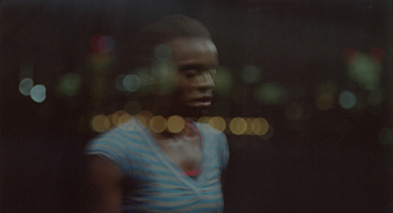
Knut Asdam Special
| | | 90:0 | Norvège | 0
.
.
Jan Koester
Catalogue : 2007Our Man In Nirvana | Animation | 35mm | couleur | 10:27 | Allemagne | 2005
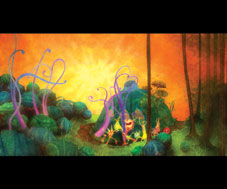
Jan Koester
Our Man In Nirvana
Animation | 35mm | couleur | 10:27 | Allemagne | 2005
John, célèbre rock-star, meurt accidentellement lors d´un concert avec son groupe, et se réveille au Nirvana. C´est là qu´il doit faire face à ses voeux et à ses actes.
Jan Koester naît en 1978 à Berlin. Après une scolarité à Fribourg et Wilhelmshaven il retourne à Berlin pour étudier l´animation au HFF "Konrad Wolf". Il achève "Our Man In Nirvana", le film qu´il tourne pour son diplôme, en Novembre 2005, après trois ans de travail. Il travaille actuellement sur un nouveau court-métrage.
Kai Foong Kok
Catalogue : 2006Life is Elsewhere | Film expérimental | dv | couleur et n&b | 7:14 | Malaisie | 2004
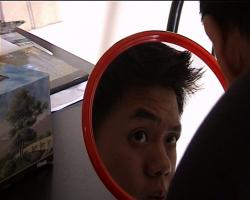
Kai Foong Kok
Life is Elsewhere
Film expérimental | dv | couleur et n&b | 7:14 | Malaisie | 2004
Avez-vous parfois l'impression d'être observé ? Qui observe qui ? La vie de qui sommes-nous en train de vivre en ce moment ? En regardant dans un miroir, qui voyons-nous ?
KOK Kai Foong a étudié les Sciences de l'Informatique à l'Université de Tamkang (Taïwan) et est devenu critique de films en 1996. Depuis 2002 il a réalisé plusieurs courts-métrages, en parallèle à son travail d'ingénieur informatique freelance.
Siew-wai Kok
Catalogue : 2008In Solitude, A Camera-eye | Vidéo expérimentale | dv | couleur | 4:25 | Malaisie | 2006
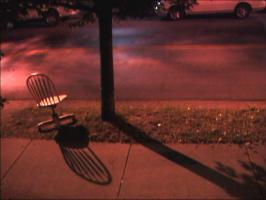
Siew-wai Kok
In Solitude, A Camera-eye
Vidéo expérimentale | dv | couleur | 4:25 | Malaisie | 2006
La vidéo a été tournée dans deux endroits: à Buffalo, New York (Etats-Unis) et à Kuala Lumpur, en Malaisie. La caméra, portée à l'épaule, est comme l'extension des yeux de l'artiste. Une nuit ventée, avant la pluie, une caméra-oeil a saisi des aspirations, la solitude et le temps.
Née et élévée à Kuala Lumpur, en Malaisie, Siew-wai Kok est une artiste spécialisée dans la vidéo, qui travaille également sur le son et les représentations. Son oeuvre explore des thèmes intimes de la vie quotidienne tels que l'émotion, la solitude et les aspirations spirituelles. Siew-wai a obtenu son Bachelor of Arts dans le domaine des médias à l'Université de Buffalo, et son Master of Fine Art d'Arts appliqués à l'électronique à Alfred University. Elle a participé à des festivals internationaux tels que le 25hrs International Videoart Show 2003 (Espagne), Signal & Noise 2006 (Canada), le Festival International du Film de Rotterdam en 2007 (Pays-Bas). Siew-wai enseigne actuellement à la Multimedia University (MMU) en Malaisie.
Alice Kok, Pascal Lièvre
Selene Kolman, Stef KOLMAN
Catalogue : 2006Tokyo Driver Caress | Fiction expérimentale | dv | couleur | 11:32 | Pays-Bas, Pays-bas | 2004
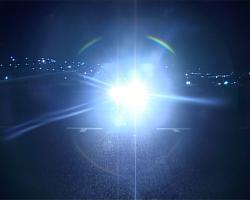
Selene Kolman, Stef KOLMAN
Tokyo Driver Caress
Fiction expérimentale | dv | couleur | 11:32 | Pays-Bas, Pays-bas | 2004
Taisuke conduit à travers les nuits d'un Tokyo futuriste. Des autoroutes lumineuses reflètent l'immensité et l'infini, avec des réseaux reliant les hommes, les véhicules et les visions. "Caress"... des images hypnotiques de voyages omniprésents de notre époque.
Selene KOLMAN est née en 1966, aux Pays-Bas. Depuis 2002, elle est enseignante à l'Université de Utrecht (Nouveaux Media et Culture Numérique) FORMATION 1994 - Maîtrise de Philosophie, Université d'Amsterdam 1993 - Licence à l'Art Academy Minerva, Groningen 1990 -Histoire de l'art propédeutique, Université de Groningen Stef KOLMAN est né en 1967 aux Pays-Bas. Depuis 2003, il est directeur artistique, MediaCatalyst, Amsterdam FORMATION 1993 - Maîtrise : M.A. History&Theory Architectural Association, Londres 1992 - Licence à la Design Academy, Eindhoven Stijn VAN SANTEN est né en 1965 à Amsterdam. Après avoir achevé ses études à la Sint Joost Academy of Art à Breda en 1992, il devient cameraman (16mm) pour "Miss Blanche" et "Leklicht" de Mark de Cloe, "Some Like It Hot" et "Can't U Hear me Singing" de Walter Stokman, "De Tijdreiziger" de Dick Tuinder et "Jannes de Film" de Rein Hazewinkel. En 1993, il reçoit le Grolsch Prize pour les nouveaux talents au cours du Festival du Film Hollandais (1993). Il réalise "Igitur, Act of Presence" et "Goud", pour lequel il remporte la Golden Flame. En 1995, il réalise "Downstairs", sélectionné pour le Golden Calf. Ses récents films sont : "Ichiko, Laatste woorden" (documentaire) et "Talmen" pour lequel il a remporté le Golden Calf et plus récemment "Profs" (Kort! 2004).
Sara Kolster, Pawel GRABOWSKI
Catalogue : 2006 | Vidéo expérimentale | dv | couleur | 2:0 | Pays-bas | 2005
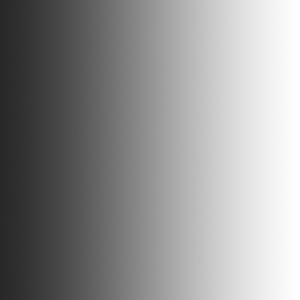
Sara Kolster, Pawel GRABOWSKI
Vidéo expérimentale | dv | couleur | 2:0 | Pays-bas | 2005
En utilisant ma caméra comme projecteur, révélant silencieusement les textures, l'espace narratif se dévoile. Les images et sons saisis rappelleront des lieux dans nos propres souvenirs. Chaque moment déterminé est comme une capsule de temps, un rappel d'un futur oublié dans le passé.
Kolster (1978-...) est une plasticienne et a une formation en design. Récemment, son travail s'est plus orienté vers la vidéo et le film, s'attachant à des détails de paysages urbains et visualisant des fragments d'histoires de ces environnements. Elle a recours à différentes stratégies, de medias tels que la vidéo, le film et la photographie, à des méthodes de recherche appartenant à diverses disciplines d'observation (journalisme, documentaire et archéologie).
Kong-chang Kong
Catalogue : 2006Name of Wu Mei | Vidéo expérimentale | dv | couleur | 16:0 | Hong Kong | 2005
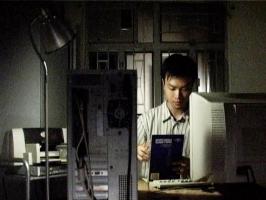
Kong-chang Kong
Name of Wu Mei
Vidéo expérimentale | dv | couleur | 16:0 | Hong Kong | 2005
L'histoire de cette vidéo est tirée d'une nouvelle, "The Name of Wu-mei", écrite par YUEN Siu-cheong. Yuen utilise une méthode de narration extraordinaire pour présenter l'histoire. Il pousse le lecteur à remettre en question son propre bon sens pendant la lecture. L'histoire parle du narrateur, Nin Kuen, qui nous raconte le procédé utilisé pour achever le roman "The Name of Wu-mei", tandis que nous découvrons, au cours de la narration, que l'intuition que l'on avait ne pourrait être qu'un mensonge de plus.
En 2000 et 2005, Kongkee est diplomé en arts plastiques à l'Université Chinoise et à la School of Creative Media, City University of Hong Kong. Il s'intéresse ensuite à la bande dessinée et aux vidéos, et crée notamment la bande dessinée en ligne : "Rice-Gas". En 2003, sa série de bandes dessinées "Imperfect Shoes" est publiée. Son récent film, réalisé en collaboration avec le romancier YUEN Siu-cheong, "Name of Wu Mei", vient d'être sélectionné par le Hong Kong Art Biennial 2005, le Musée d'Art de Hong Kong. Filmographie vidéo : "Negative Record"(2000), "Princess Cheung Ping"(2004).
Aglaia Konrad
Catalogue : 2015Das Haus | Film expérimental | 16mm | couleur | 21:40 | Autriche | 2014
Aglaia Konrad
Das Haus
Film expérimental | 16mm | couleur | 21:40 | Autriche | 2014
Das Haus deepens the exploration of sculptural architecture that Aglaia Konrad conducted with the series of 16mm films Concrete and Samples. Shot in a house designed by architect Juliaan Lampens in Sint-Martens-Latem (Belgium), the film resumes the artist’s interest on the possibilities of the cinematic medium to generate –rather than capture - an architectural experience. An experience which, in this film, surpasses the visual to mobilize bodily perception and even desire. Konrad’s editing carefully measures the doses of perceptual information it provides to our orientation drive in a process that departs from an initial willingness to orient oneself towards the pleasure of surrendering to disorientation and fragmentation. A disorientation that could be called “perverse” in the sense that Freud bestowed to the word –perverse pleasures are those which linger in the detour; in the resistance to result in a productive goal– insofar as the film replaces the production of a representation of space in favour of perceptive defamiliarization and tactile pleasure. Architecture and film are constantly looking at each other in a piece in which "angle", "transition", "cut", "sequence", "frame", " joint", " fold " and "rhythm" are notions that are spread from one discipline to the other as if the camera and editing would be reading the space as a composition score. There are two architectural comparisons that are often applied to filmmaking: the idea of cinema as a "window" and as “mirror". Das Haus, entangles and complicates those comparisons by treating windows as interfaces that blur the inside and outside and whose transparency acquires materiality, and by using mirrors as devices that disrupt form pushing it to a state of potentiality. In Das Haus the screen is no longer a window but rather a skin: for it is a body interface, a tactile surface and a membrane that is neither safe nor transparent because it reveals its inner cinematic compositional strategies.
Aglaia Konrad is a photography based artist living in Brussels whose work has focused mainly on metropolitan urban space. She has been advising researcher at the Jan Van Eyck Academy in Maastricht and is currently teaching at the Hogeschool Sint-Lukas in Brussels. She had presented her work in solo exhibitions in Siegen, Antwerp, Geneva, Graz, Cologne and New York, among other cities, as well as in international group shows such as Documenta X (1997), Cities on the Move (1998-1999) and Talking Cities (2006). Her work has been documented in several exhibitions catalogues and monographic publications such as 'Elasticity' (2002) and 'Iconocity' (2005). For her book 'Desert Cities' (2008) she received the Infinity award for the best photo book 2009 of the International Center for Photography, New York. The book 'Carrara' (2011) won the Fernand Baudin Prize 2011. Before the trilogy Concrete & Samples (2009-2010) she made the film Sculpture House (2008, 12'05") based on a house built in 1968 around Liège (BE) by Jacques Gillet, Felix Roulin and René Greisch.
Aglaia Konrad
Catalogue : 2017La Scala | Film expérimental | 16mm | couleur | 12:24 | Autriche, Belgique | 2016
Aglaia Konrad
La Scala
Film expérimental | 16mm | couleur | 12:24 | Autriche, Belgique | 2016
The subject of Aglaia Konrad’s 16mm films is modernist architecture but rather than a form of architecture on film, or film on architecture, her films investigate the potential for film to embody the experience of architecture as sculpture. The protagonist here is ‘La Scala’, a villa on Lake Garda, designed by Vittoriano Vigano for André Bloc in 1958. The ‘multiple projection’ (split-screen) of La Scala proposes a multiplicity of perspectives and, more significantly, a succession of combined images.
Aglaia Konrad (1960, Salzburg) criss-crosses urban spaces. Her photographs, films and installations zoom in on exceptional buildings and the transformation of cities. She focuses on the way architecture is visualised and exhibited. Aglaia Konrad lives in Brussels and teaches at LUCA School of Arts. She had presented her work in solo exhibitions in Siegen, Antwerp, Geneva, Graz, Cologne and New York, among other cities, as well as in international group shows such as Documenta X (1997), Cities on the Move (1998-1999) and Talking Cities (2006). Her work has been documented in several exhibitions catalogues and monographic publications such as ‘Elasticity’ (2002) and ‘Iconocity’ (2005). For her book ‘Desert Cities’ (2008) she received the Infinity award for the best photo book 2009 of the International Center for Photography, New York. The book ‘Carrara’ (2011) won the Fernand Baudin Prize 2011. In 2016 she published ‘From A to K’ (Buchhandlung Walther Konig).
Aglaia Konrad
Catalogue : 2015sequenza | Film expérimental | 16mm | couleur | 14:0 | Belgique | 2014
Manon De Boer, George van Dam
sequenza
Film expérimental | 16mm | couleur | 14:0 | Belgique | 2014
Sequenza is an experimental film project by Manon de Boer and George van Dam based on the composition Sequenza VIII for solo violin by Luciano Berio . From a long history of cooperation - to include the soundtrack of Manon de Boer's film trilogy Sylvia Kristel - Paris (2003), Resonating Surfaces (2005) and Think about Wood, Think about Metal (2011) and her portrait of George van Dam in Presto, Perfect Sound (2006) - came the desire to work together to make a movie based on Sequenza VIII . This piece is for its crystalline structure one of the most beloved compositions by George van Dam . Together with Manon de Boer, he wants to explore how rhythm and structure of this composition can be articulated in conjunction with moving images to penetrate. So even deeper into the composition Manon de Boer is fascinated by the image of the intimate contact of the chin, the ears, the face of the violinist with the violin, which extends in the movement of his arms and hands to the body and space, the instrument - body of the violin as a material, physical transition between two abstract elusive poles : that of the mental construction of the composition and experience of its sounds in space. Van Dam and de Boer have developed the following idea from these different interests. In several recordings of Dam filmed (and sound is recorded) when he performs Sequenza VIII . Emphasizing first half total, the body and the intimacy with the instrument. Then abstract details filmed, like his hands, his ear, details of the violin, strings and the like. In the editing is from the portrait / body of the violinist a more fragmented, abstract image created a physical, gives spatial experience in the tension between the music and the image rhythm. If the body and the violin in abstract details and solve dancing away in the (sound) space.
Manon de Boer (°1966 in Kodaicanal, India) completed her artistic education at the Akademie Van Beeldende Kunsten, Rotterdam, and at the Rijksakademie van Beeldende Kunsten in Amsterdam. Using personal narration and musical interpretation as both method and subject, de Boer explores the relationship between language, time, and truth claims to produce a series of portrait films in which the film medium itself is continuously interrogated. Her work has been exhibited internationally, at the Venice Biennial (2007), Berlin Biennial (2008), Sao Paolo Biennial (2010), Documenta (2012) and has also been included in numerous film festivals in Hong Kong, Marseille, Rotterdam and Vienna. Her work has been the subject of monographic exhibitions at Witte de With in Rotterdam (2008), Frankfurter Kunstverein (2008), London South Gallery (2010), Index in Stockholm (2011), Contemporary Art Museum of St Louis (2011) and Museum of Art Philadelphia (2012), among others. De Boer currently teaches at the School of Arts in Ghent and ERG in Brussels. She lives and works in Brussels.
Catalogue : 2011Concrete & Samples I Wotruba Wien | Doc. expérimental | 16mm | couleur | 16:30 | Belgique | 2009
Aglaia Konrad
Concrete & Samples I Wotruba Wien
Doc. expérimental | 16mm | couleur | 16:30 | Belgique | 2009
Concrete & Samples I, II, III is a series of 16mm films on sculptural architecture. What the buildings and site in all films have in common is the idea of ?architecture as sculpture? and a very distinct use of concrete that seem to depart from the free form of the whole in a sculptural manner. In the absence of a traditional narrative, it is the space itself, that takes the role of the protagonist, while the camera proposes a narration through its travel and observation. The church of Fritz Wotruba, in Vienna looks like an enlarged piece of abstract sculpture, a kind of three-dimensional synthetic cubist arrangement of 152 concrete blocks arranged vertically and horizontally, but asymmetrically, in which the narrow spaces produced in-between are made use of as windows and doors.
Aglaia Konrad is a photography based artist living in Brussels whose work has focused mainly on metropolitan urban space. She has been advising researcher at the Jan Van Eyck Academy in Maastricht and is currently teaching at the Hogeschool Sint-Lukas in Brussels. She had presented her work in solo exhibitions in Siegen, Antwerp, Geneva, Graz, Cologne and New York, among other cities, as well as in international group shows such as Documenta X (1997), Cities on the Move (1998-1999) and Talking Cities (2006). Her work has been documented in several exhibitions catalogues and monographic publications such as `Elasticity` (2002) and `Iconocity` (2005). For her latest book `Desert Cities` (2008) she received the Infinity award for the best photo book 2009 of the International Center for Photography, New York.
Catalogue : 2009Two Times 4'33 | Doc. expérimental | 35mm | couleur | 11:0 | Belgique | 2008
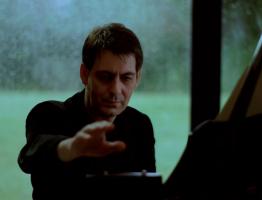
Herman Asselberghs
Two Times 4'33
Doc. expérimental | 35mm | couleur | 11:0 | Belgique | 2008
De Boer a invité le pianiste basé à Bruxelles Jean-Luc Fafchamps à jouer deux fois de suite la composition « 4?33?? » de John Cage devant un auditoire, dans un studio des P.A.R.T.S. (Performing Arts Research and Training Studios) de Bruxelles (Belgique). En une seule prise, la caméra filme l'exécution de cette composition musicale « silencieuse », avec les trois signes de ponctuation indiqués par Cage sur l?unique ligne de la partition à 1'40", 2'23" et 2?30", que Fafchamps, qui demeure le reste du temps toujours calme et absorbé, interprète en touchant un chronomètre. Tournée sur une pellicule 35 millimètres, ce qui assure la netteté des détails visuels, cette première partie est mariée à un son ambiant enregistré de façon synchrone, joué en surround Dolby lorsque l'?uvre est projetée. À la seconde interprétation, qui correspond à la deuxième partie du film, De Boer coupe tous les sons, à part les clics du chronomètre de l?exécution.
Manon de Boer est née en Inde, vit et travaille à Bruxelles (Belgique). Elle réalise des films, des vidéos, des installations, publie et enseigne à KASK. Elle fait partie de la plateforme de production-distribution Auguste Orts. Utilisant la narration personnelle comme une méthode, Manon de Boer explore la relation entre le langage, le temps et les revendications de vérité. Elle explore également la perception du temps par le biais d?un usage conscient du film en tant que médiateur artistique, et par l?analyse de ses effets sur le spectateur. La façon dont elle désincarne l?image, le son et la musique dans ses compositions, modifie subtilement le schéma classique de la perception du film.
Sara Kontar
Catalogue : 20253350 KM | Doc. expérimental | hdv | couleur | 13:0 | Syrie, France | 2023

Sara Kontar
3350 KM
Doc. expérimental | hdv | couleur | 13:0 | Syrie, France | 2023
En exil, 7 ans loin de mon père et de mon pays, j'enregistre nos conversations téléphoniques. Il me parle du pays, de sa solitude. Mon écran nous unit et sépare, ma seule fenêtre. Mes souvenirs s'estompent, ma vie coupée, mon pays inaccessible.
Sara Kontar est une artiste, photographe et réalisatrice syrienne installée en France depuis 2016. Elle est titulaire d'un Master en cinéma d'animation de l'École Nationale Supérieure des Arts Décoratifs de Paris (ENSAD). Son travail englobe la photographie documentaire et artistique, avec des expositions internationales et une reconnaissance, notamment le prix Inge Morath. "3350 KM" est son premier documentaire expérimental, après avoir réalisé des œuvres vidéo expérimentales présentées dans des lieux tels que le Centre Pompidou et le Palais de Tokyo. Le travail de Kontar explore ses racines et l'expérience de l'exil, exprimant les émotions humaines d'une manière personnelle et intime. Elle est également la fondatrice d'"Al-Ayoun", un espace dédié aux conteurs visuels en Syrie et dans la diaspora.
Frank Koolen, Kasper Jacobs
Catalogue : 2016Play Curacao | Doc. expérimental | hdv | couleur | 29:28 | Pays-Bas, Curaçao | 2015
Frank Koolen, Kasper Jacobs
Play Curacao
Doc. expérimental | hdv | couleur | 29:28 | Pays-Bas, Curaçao | 2015
In the experimental documentary Play Curacao (2015) contemporary games, social rituals and leisure typical for the Caribbean island of Curacao are thoroughly investigated through a mix of observations, discussions and performative acts. During a four month residency at the Instituto Buena Bista artists/filmmakers Kasper Jacobs and Frank Koolen followed a wide variety of sub-cultures and singletons in their free-time routines resulting in a personal taxonomy of the Caribbean ‘Homo Ludens’. Play Curacao offers a dynamic, absurd and playful insight in the versatile everyday society and culture of Curacao.
Kasper Jacobs and Frank koolen, both visual artists working in the field of film and photography, met in 2007 and since then have been assisting each other frequently in a range of individual projects. Through these collaborations they created a mutual frame of preference and understanding. Their shared interest in subcultures and the structures they create to frame their own reality form the fundament of `Play Curacao` and future projects. Kasper Jacobs (1981, Bergen, NL) studied at the Gerrit Rietveld Academie in Amsterdam. Frank Koolen (1978, Maastricht, NL) studied at the HKU in Utrecht, De Ateliers and the Rijksakademie van Beeldende Kunsten in Amsterdam.
Jan Kopp
Catalogue : 2013Les balançoires | Animation | hdv | noir et blanc | 4:15 | Allemagne, France | 2011
Jan Kopp
Les balançoires
Animation | hdv | noir et blanc | 4:15 | Allemagne, France | 2011
.
Born 1970 in Frankfurt/Main, lives in Paris and Berlin 1992-1994 : studies philosophy at Paris IV, la Sorbonne. 1996 : graduates from Ecole Nat. Sup. des Beaux Arts, Paris.
Efthimis Kosemund Sanidis
Catalogue : 2018Astrometal | Fiction | 4k | couleur | 15:55 | Grèce | 2017
Efthimis Kosemund Sanidis
Astrometal
Fiction | 4k | couleur | 15:55 | Grèce | 2017
Two boys and a girl prepare for nightclubbing in the heart of Athens. Arriving, they face a deserted club, where music plays blaring but there is no one to listen. There, one by one falls asleep as they surrender themselves in a collective dream.
Born with dual Greek/German nationality, Efthimis Kosemund Sanidis studied Informatics Engineering, and then Contemporary Arts at Le Fresnoy - Studio National in France. His films have won acclaim at festivals around the world. His debut short film, “ II ” (2014, 16’), won the Pack & Pitch award at Sarajevo while in development, followed by a world premiere in the Pardi di Domani section of the Locarno Film Festival. He shot his next two films, “ Odette ” (2015, 16’) and “ Unbuilt Light ” (2017, 29’), while in residency at Le Fresnoy, with the latter opening in competition in Sarajevo. “ Astrometal ” (2017, 15’) was nominated for a Golden Lion in the Orizzonti section of the 74th Venice International Film Festival.